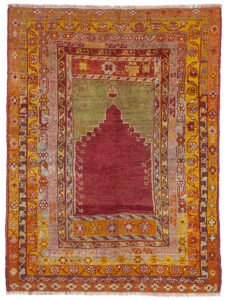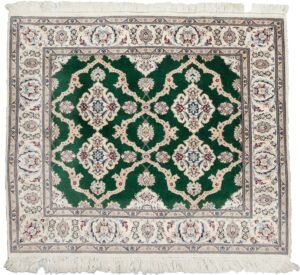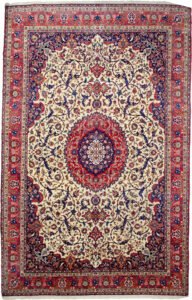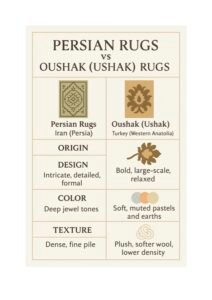✨ The Influence of Islamic Art in Handmade Rugs
- By Mehdi Sharafi
- Published:
- Last updated: October 17, 2025
The rich traditions of Islamic art have deeply influenced the design and craftsmanship of handmade rugs for centuries. From intricate geometric patterns to stylised florals and calligraphic symbolism, Islamic design principles are woven — quite literally — into the very fabric of the world’s most beautiful carpets.
At Sharafi & Co, we honour these traditions by sourcing and creating pieces that reflect the timeless aesthetics and spiritual heritage of Islamic artistry.
🕌 What Is Islamic Art?
Islamic art encompasses the visual culture of Muslim societies from the 7th century onward, spanning architecture, ceramics, textiles, and manuscripts across the Middle East, North Africa, Central Asia, and beyond.
Key characteristics include:
-
Geometric pattern and symmetry
-
Arabesque (flowing, interlaced floral forms)
-
Calligraphy, particularly in Arabic script
-
Aniconism – the avoidance of human or animal depictions in sacred art
-
Symbolism, often reflecting divine order and unity
These artistic principles are not merely decorative — they are deeply spiritual, intended to reflect the infinite nature of the divine through repeating patterns and balanced compositions.

🧶 How Islamic Art Influenced Rug Design
Islamic art and handmade rugs evolved together in the Islamic world — from the courts of Persia and the palaces of the Ottoman Empire to the homes of artisans and nomads.
Here’s how this influence shows up in rug design:
1. Geometric Patterns and Symmetry
Islamic geometric art focuses on mathematical precision and endless repetition. In rug design, this translates into:
-
Latticework layouts
-
Star and polygon-based medallions
-
Intricate borders with repeating motifs
2. Arabesque and Floral Motifs
Floral patterns in rugs often follow the rules of arabesque design, where vines and leaves intertwine endlessly. You’ll find these in:
-
Persian medallion carpets
-
Ottoman floral Oushaks
-
Indian Mughal carpets with stylised tulips and palmettes
3. Symbolism and Metaphor
Many rug motifs hold symbolic meaning:
-
Mihrab (prayer arch) in prayer rugs mirrors mosque architecture
-
Stars, domes, or tree-of-life motifs represent the heavens or paradise
-
Endless knot patterns evoke the infinite and the eternal
These elements bridge form and function — beautifying homes while supporting spiritual practices.
4. Calligraphic Elements
Though less common in floor rugs, calligraphy — often verses from the Qur’an — features in some Islamic carpets, especially wall-hanging textiles and royal commissions. These elevate the rug into a sacred object of meditation or honour.

🧵 Iconic Examples of Islamic-Inspired Rugs
✅ Persian Safavid Carpets (16th–17th century)
Often featuring central medallions, intricate borders, and palmette motifs — considered masterpieces of Islamic textile art.
✅ Ottoman Ushak Rugs
Favoured in Europe during the Renaissance, these rugs showcase large floral designs and spacious, calming layouts.
✅ Mamluk Rugs (Egypt, 15th century)
Complex geometric forms, star medallions, and unusual colour combinations — a marriage of craftsmanship and sacred design.

🏡 Islamic Design in Contemporary Interiors
Today, Islamic art’s influence on rugs continues to shape interior design:
-
Geometric kilims in minimalist and boho homes
-
Floral medallion Persian rugs in traditional and heritage settings
-
Custom-made rugs with arabesque or Islamic-inspired symmetry for statement rooms
Designers and collectors increasingly value rugs not just for their beauty, but for the cultural heritage they carry.

📍 Explore Rugs Inspired by Islamic Art at Sharafi & Co
Our collection includes:
-
Antique and vintage rugs influenced by Islamic traditions
-
Handmade Persian and Turkish carpets with spiritual and geometric motifs
-
Custom and bespoke rugs based on Islamic design principles
-
Pieces suitable for homes, prayer spaces, and cultural institutions
🛍 Explore Our Collection
[📞 +44 (0)20 8735 0701]
[✉️ info@sharafiandco.com]

